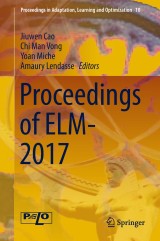Details

Proceedings of ELM-2017
Proceedings in Adaptation, Learning and Optimization, Band 10
|
213,99 € |
|
| Verlag: | Springer |
| Format: | |
| Veröffentl.: | 16.10.2018 |
| ISBN/EAN: | 9783030015206 |
| Sprache: | englisch |
Dieses eBook enthält ein Wasserzeichen.
Beschreibungen
<p></p><p>This book contains some selected papers from the International Conference on Extreme Learning Machine (ELM) 2017, held in Yantai, China, October 4–7, 2017. The book covers theories, algorithms and applications of ELM.</p><p>Extreme Learning Machines (ELM) aims to enable pervasive learning and pervasive intelligence. As advocated by ELM theories, it is exciting to see the convergence of machine learning and biological learning from the long-term point of view. ELM may be one of the fundamental `learning particles’ filling the gaps between machine learning and biological learning (of which activation functions are even unknown). ELM represents a suite of (machine and biological) learning techniques in which hidden neurons need not be tuned: inherited from their ancestors or randomly generated. ELM learning theories show that effective learning algorithms can be derived based on randomly generated hidden neurons (biological neurons, artificial neurons, wavelets, Fourier series,etc) as long as they are nonlinear piecewise continuous, independent of training data and application environments. Increasingly, evidence from neuroscience suggests that similar principles apply in biological learning systems. ELM theories and algorithms argue that “random hidden neurons” capture an essential aspect of biological learning mechanisms as well as the intuitive sense that the efficiency of biological learning need not rely on computing power of neurons. ELM theories thus hint at possible reasons why the brain is more intelligent and effective than current computers.</p><p> </p><p>This conference will provide a forum for academics, researchers and engineers to share and exchange R&D experience on both theoretical studies and practical applications of the ELM technique and brain learning.</p><p> </p><p>It gives readers a glance of the most recent advances of ELM.</p><p> </p><p> </p><p></p>
Adaptive Control of Vehicle Yaw Rate with Active Steering System and Extreme Learning Machine.- Sparse representation feature for facial expression recognition.- Protecting User Privacy in Mobile Environment using ELM-UPP.- Application Study of Extreme Learning Machine in Image Edge Extraction.- A Normalized Mutual Information Estimator Compensating Variance Fluctuations.- Reconstructing Bifurcation Diagrams of Induction Motor Drives using an Extreme Learning Machine.- Ensemble based error minimization reduction forELM.- The Parameter Updating Method Based onKalman Filter for Online Sequential ExtremeLearning Machine.- Extreme Learning Machine BasedShip Detection Using Synthetic Aperture Radar.
<p></p><p>This book contains some selected papers from the International Conference on Extreme Learning Machine (ELM) 2017, held in Yantai, China, October 4–7, 2017. The book covers theories, algorithms and applications of ELM.</p><p> </p><p>Extreme Learning Machines (ELM) aims to enable pervasive learning and pervasive intelligence. As advocated by ELM theories, it is exciting to see the convergence of machine learning and biological learning from the long-term point of view. ELM may be one of the fundamental `learning particles’ filling the gaps between machine learning and biological learning (of which activation functions are even unknown). ELM represents a suite of (machine and biological) learning techniques in which hidden neurons need not be tuned: inherited from their ancestors or randomly generated. ELM learning theories show that effective learning algorithms can be derived based on randomly generated hidden neurons (biological neurons, artificial neurons, wavelets, Fourier series, etc) as long as they are nonlinear piecewise continuous, independent of training data and application environments. Increasingly, evidence from neuroscience suggests that similar principles apply in biological learning systems. ELM theories and algorithms argue that “random hidden neurons” capture an essential aspect of biological learning mechanisms as well as the intuitive sense that the efficiency of biological learning need not rely on computing power of neurons. ELM theories thus hint at possible reasons why the brain is more intelligent and effective than current computers.</p><p> </p><p>This conference will provide a forum for academics, researchers and engineers to share and exchange R&D experience on both theoretical studies and practical applications of the ELM technique and brain learning.</p><p> </p><p>It gives readers a glance of the most recent advances of ELM.</p><p> </p><p> </p><p></p>
Provides recent research on Extreme Learning Machine Includes selected papers from the International Conference on Extreme Learning Machine 2017, which was held in Yantai, China, October 4–7, 2017 Presents Theory, Algorithms and Applications

















